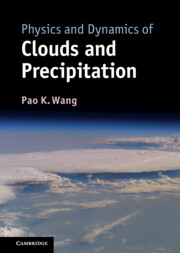Book contents
- Frontmatter
- Contents
- Preface
- 1 Observation of clouds
- 2 The shape and size of cloud and precipitation particles
- 3 Molecular structures of water substance
- 4 Bulk thermodynamic equilibrium among water vapor, liquid water, and ice
- 5 Surface thermodynamics of water substance
- 6 Aerosol in the atmosphere
- 7 Nucleation
- 8 Hydrodynamics of cloud and precipitation particles
- 9 Diffusion growth and evaporation of cloud and precipitation particles
- 10 Collision, coalescence, breakup, and melting
- 11 Cloud drop population dynamics in the warm rain process
- 12 Fundamental cloud dynamics
- 13 Numerical cloud models
- 14 Cloud electricity
- 15 Clouds–environment interaction
- References
- Index
- Plate section
14 - Cloud electricity
Published online by Cambridge University Press: 05 March 2013
- Frontmatter
- Contents
- Preface
- 1 Observation of clouds
- 2 The shape and size of cloud and precipitation particles
- 3 Molecular structures of water substance
- 4 Bulk thermodynamic equilibrium among water vapor, liquid water, and ice
- 5 Surface thermodynamics of water substance
- 6 Aerosol in the atmosphere
- 7 Nucleation
- 8 Hydrodynamics of cloud and precipitation particles
- 9 Diffusion growth and evaporation of cloud and precipitation particles
- 10 Collision, coalescence, breakup, and melting
- 11 Cloud drop population dynamics in the warm rain process
- 12 Fundamental cloud dynamics
- 13 Numerical cloud models
- 14 Cloud electricity
- 15 Clouds–environment interaction
- References
- Index
- Plate section
Summary
Thunderstorms are among the most impressive weather phenomena with their strong winds and sometimes heavy rain and hail. But what distinguishes them from other storms is the lightning and thunder that are their trademark.
It is well known that it is lightning that causes thunder. But the lightning itself is caused by charge separation in a cloud, a process called cloud electrification that is still not totally understood at present. In this chapter, we will first examine the electricity in air during fair weather, and then we will discuss the electrical phenomena occurring during a thunderstorm. Finally, we will discuss the mechanisms that may be responsible for the electrification of thunderclouds.
Fair-weather electricity
Electricity in the atmosphere is not limited to stormy weather. During a clear day, a downward-pointing static electric field of about 130Vm−1 (volts per meter) near the Earth’s surface can be measured and is called the fair-weather electric field (see Fig. 14.1). This is just a highly averaged condition, and large variations may occur for specific locations and specific times – the field may vary from less than 50Vm−1 to more than 300Vm−1. In general, this fair-weather field is usually larger over land than over the ocean surface.
- Type
- Chapter
- Information
- Physics and Dynamics of Clouds and Precipitation , pp. 363 - 395Publisher: Cambridge University PressPrint publication year: 2013



